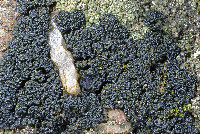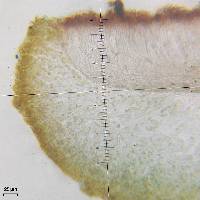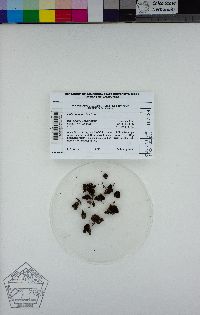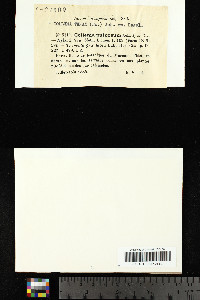
Consortium of Lichen Herbaria
- building a Global Consortium of Bryophytes and Lichens as keystones of cryptobiotic communities -
- Home
- Search
- Images
- Species Checklists
- US States: O-Z >
- US National Parks
- Central America
- South America
- US National Parks
- Southern Subpolar Region
|
|
|
|
Family: Collemataceae
[Collema auriculatum var. ceranoides (Borrer) Nyl., moreCollema ceranoides Borrer, Collema crispum subsp. ceranoides (Borrer) Nyl. ex Cromb., Collema crispum var. cristatulum Nyl. ex Cromb., Collema pulposum (Bernh.) Ach., Collema pulposum f. compactum , Collema pulposum f. hydrocharum , Collema pulposum f. papulosum Schaer., Collema pulposum f. pulposum (Bernh.) Ach., Collema pulposum var. ceranoides (Borrer) Leight., Collema pulposum var. compactum (Ach.) Nyl., Collema pulposum var. confertum Harm., Collema pulposum var. corallinum A. Massal., Collema pulposum var. cristatum , Collema pulposum var. diffractoareolatum Schaer., Collema pulposum var. ligerinum Hy, Collema pulposum var. pulposulum (Nyl.) Cromb., Collema pulposum var. pulposum (Bernh.) Ach., Collema pulposum var. tenax (Sw.) Nyl., Collema pulposum var. uniseptatum Zahlbr., Collema pulposum var. vulgare Schaer., Collema tenax (Sw.) Ach., Collema tenax f. tenax (Sw.) Ach., Collema tenax var. ceranoides (Borrer) Degel., Collema tenax var. corallinum (A. Massal.) Degel., Collema tenax var. coronatum Körb., Collema tenax var. tenax (Sw.) Ach., Collema tenax var. vulgare (Schaer.) Degel., Eucollema ceranoides (Borrer) Horw., Eucollema ceranoides f. ceranoides (Borrer) Horw., Eucollema ceranoides f. cristatulum (Nyl. ex Cromb.) Horw., Leptogium palmatum f. corallinum (A. Massal.) Zahlbr.] |
Nash, T.H., Ryan, B.D., Gries, C., Bungartz, F., (eds.) 2004. Lichen Flora of the Greater Sonoran Desert Region. Vol 2. Thallus: foliose, often appearing subcrustose, small to large, (1-)3-4(-10) cm wide, loosely attached or somewhat ascending, rather thick, much swollen when moist, rounded or becoming irregular, deeply lobate lobes: very variable in size, usually rather short and few mm broad, 0.1-1 mm thick when moist, radiating from the center or irregularly developed, somewhat elongated, usually broader towards tips, contiguous to imbricate or separate, usually crenate to lobulate, flattened or somewhat concave, usually with a few coarse, simple to branched folds upper surface: smooth to slightly rugulose or coarsely folded, light or dark olive-green to blackish brown, usually pale green in shade, sometimes bluish green, dull or with a silky gloss, epruinose or sometimes ±gray pruinose due to calcareous dust isidia: absent or present, globose, sometimes elongated, accessory ±teretiform lobules resemble isidia lower surface: usually somewhat paler, rhizines white, usually crowded and forming hapters Apothecia: absent or numerous, sometimes crowded, laminal or sometimes marginal, sessile with constricted base, sometimes adnate, rarely immersed, (0.5-)1.5-3(-6) mm wide disc: at first ±concave, then plane, finally often ±convex, light or dark red to red-brown or black, dull or somewhat glossy, smooth, epruinose thalline margin: thin to rather thick, usually entire, smooth, rarely somewhat crenulate or finely rugose or lobulate, inconspicuous or slightly prominent, persistent or finally disappearing, lacking a pseudocortex proper margin: thin, up to 30 µm wide, euthyplectenchymatous hymenium: hyaline, (65-)80-110 µm tall asci: narrowly clavate to subcylindrical, 8-spored, rarely with fewer spores ascospores: hyaline, straight, fusiform to narrowly ovoid with ±acute ends, (2-3-)4-celled, generally ±constricted at septa, (15-)17-26(30) x (5-)6.5-8.5 µm, or ellipsoid to broadly ovoid with ± obtuse or rounded ends, submuriform with 3(-4) transverse septa and 1-2 longitudinal septa, 17-26(30) x 8.5-10.5(-13) µm Pycnidia: laminal or marginal, immersed to semi-immersed, ±globose, 200-260 µm wide, pale conidia: bacilliform, with slightly swollen ends, 4.5-6 x 1.5-1.8(-2) µm Spot tests: all negative Secondary metabolites: none detected. Substrate and ecology: usually on various soils or soil over rock, rarely on calcareous or siliceous rocks or mosses over rocks, usually in ±moist but also in rather dry habitats, low to high elevations World distribution: North and South America, Greenland, Europe, Mediterranean, Macaronesia, Near and Middle East, Africa, and Asia Sonoran distribution: throughout Arizona, southern California, Baja California, Baja California Sur, Sonora and Chihuahua. Notes: Collema tenax is a very variable species in habit, thallus color, isidia, apothecia and ascospores. Similarly variable is Collema coccophorum, but it has 2-celled ascospores. Collema polycarpon var. corcyrense is also similar. However, that species grows on rock. Four varieties of C. tenax are distinguished among the material from the American Southwest. Variety corallinum seems to be rather common and is characterized by rather small thalli with knotty, short lobes and abundant isidia that finally become elongated forming coralloid clusters in the central, older thallus parts; variety crustaceum is similar but lacks the isidiate clusters; the varieties vulgare and expansum have distinct, elongated, often radiating lobes with distinctly widened tips. In var. expansum the lobes are silky glossy and broad (up to 5 mm wide), whereas in var. vulgare the silky gloss is lacking and the lobes are more narrow. |
|
|
|
Powered by Symbiota








































































































